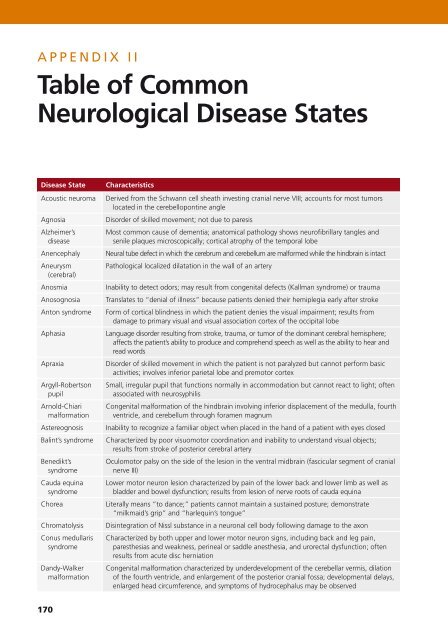Create successful ePaper yourself
Turn your PDF publications into a flip-book with our unique Google optimized e-Paper software.
APPENDIX II<br />
Table of Common<br />
Neurological Disease States<br />
Disease State<br />
Acoustic neuroma<br />
Agnosia<br />
Alzheimer’s<br />
disease<br />
Anencephaly<br />
Aneurysm<br />
(cerebral)<br />
Anosmia<br />
Anosognosia<br />
Anton syndrome<br />
Aphasia<br />
Apraxia<br />
Argyll-Robertson<br />
pupil<br />
Arnold-Chiari<br />
malformation<br />
Astereognosis<br />
Balint’s syndrome<br />
Benedikt’s<br />
syndrome<br />
Cauda equina<br />
syndrome<br />
Chorea<br />
Chromatolysis<br />
Conus medullaris<br />
syndrome<br />
Dandy-Walker<br />
malformation<br />
Characteristics<br />
Derived from the Schwann cell sheath investing cranial nerve VIII; accounts for most tumors<br />
located in the cerebellopontine angle<br />
Disorder of skilled movement; not due to paresis<br />
Most common cause of dementia; anatomical pathology shows neurofibrillary tangles and<br />
senile plaques microscopically; cortical atrophy of the temporal lobe<br />
Neural tube defect in which the cerebrum and cerebellum are malformed while the hindbrain is intact<br />
Pathological localized dilatation in the wall of an artery<br />
Inability to detect odors; may result from congenital defects (Kallman syndrome) or trauma<br />
Translates to “denial of illness” because patients denied their hemiplegia early after stroke<br />
Form of cortical blindness in which the patient denies the visual impairment; results from<br />
damage to primary visual and visual association cortex of the occipital lobe<br />
Language disorder resulting from stroke, trauma, or tumor of the dominant cerebral hemisphere;<br />
affects the patient’s ability to produce and comprehend speech as well as the ability to hear and<br />
read words<br />
Disorder of skilled movement in which the patient is not paralyzed but cannot perform basic<br />
activities; involves inferior parietal lobe and premotor cortex<br />
Small, irregular pupil that functions normally in accommodation but cannot react to light; often<br />
associated with neurosyphilis<br />
Congenital malformation of the hindbrain involving inferior displacement of the medulla, fourth<br />
ventricle, and cerebellum through foramen magnum<br />
Inability to recognize a familiar object when placed in the hand of a patient with eyes closed<br />
Characterized by poor visuomotor coordination and inability to understand visual objects;<br />
results from stroke of posterior cerebral artery<br />
Oculomotor palsy on the side of the lesion in the ventral midbrain (fascicular segment of cranial<br />
nerve III)<br />
Lower motor neuron lesion characterized by pain of the lower back and lower limb as well as<br />
bladder and bowel dysfunction; results from lesion of nerve roots of cauda equina<br />
Literally means “to dance;” patients cannot maintain a sustained posture; demonstrate<br />
“milkmaid’s grip” and “harlequin’s tongue”<br />
Disintegration of Nissl substance in a neuronal cell body following damage to the axon<br />
Characterized by both upper and lower motor neuron signs, including back and leg pain,<br />
paresthesias and weakness, perineal or saddle anesthesia, and urorectal dysfunction; often<br />
results from acute disc herniation<br />
Congenital malformation characterized by underdevelopment of the cerebellar vermis, dilation<br />
of the fourth ventricle, and enlargement of the posterior cranial fossa; developmental delays,<br />
enlarged head circumference, and symptoms of hydrocephalus may be observed<br />
170


